CHAPTER EIGHT
WORLD WAR (ROUND TWO) … AND A RESULTING COLD WAR
THE PATH TO WAR
Britain and France found themselves deeply concerned about the behavior they were seeing (Hitler’s Germany) or hearing about (Stalin’s Russia), and were most uncertain about how to respond to such rising dictatorship. Indeed they were quite split on the matter, some seeing Hitler as the greater danger – and thus wanting to side with Stalin, Hitler’s supposed prime enemy. Others were very afraid of the worker radicalism stirring in Europe, fearing Stalin’s ability to manipulate all this, and consequently saw Hitler as the West’s best barrier against Stalin. Ultimately, British Prime Minister Chamberlain (and much of the ranks of the royalty) tended to take the anti-Stalin and thus pro-Hitler position – much to the chagrin of former British leader Winston Churchill, who, though he did not like Stalin, distrusted Hitler even more.
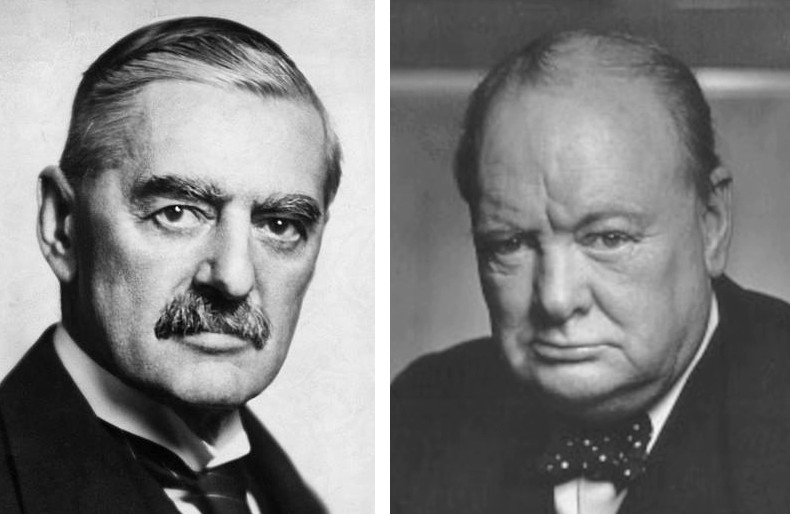
Chamberlain Churchill
Unfortunately for Czechoslovakia, to appease Hitler, Chamberlain agreed at a meeting in Munich, Germany (September 1938), to let Hitler take over the German-speaking Sudetenland border region of Czechoslovakia. Sadly, this region was Czechoslovakia’s main realm of national defense … with 40 well-armed Czech military divisions based there. But Chamberlain believed that in forcing the Czechs to agree to this transfer, this would quiet Hitler − and spare Europe from the outbreak of another nasty war.
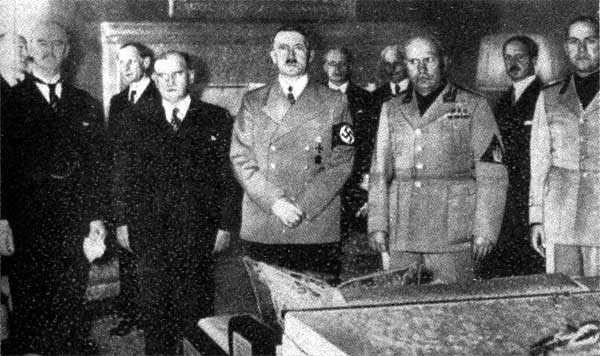
Chamberlain, French Prime Minister Daladier, Hitler, Mussolini, and his son-in-law Ciano at Munich
But Hitler esteemed this only to be further proof of British weakness, and despite the promise that all he wanted from Czechoslovakia was the Sudetenland, the next spring (March), Hitler marched his Nazi troops into Czechoslovakia, to take over the whole country.
At this, an outraged Chamberlain threatened Hitler that if he were to pull another stunt like that (probably Poland, where Hitler clearly had a similar expansionist program in mind) this would mean war. Hitler was not impressed.
America. And what was Roosevelt’s America doing about all of this at the time? Congress intended, in passing annually a Neutrality Act (1935, 1936, 1937 and 1939), to make it clear that Roosevelt was to keep America out of another military involvement in the affairs of the “Old World” (Europe). Roosevelt, however, was not blind, had actually turned his presidential attention to foreign affairs after the New Deal ran out of steam sometime around 1937, and did what he could to put America in a state of mind more able to deal with problems obviously headed its way.
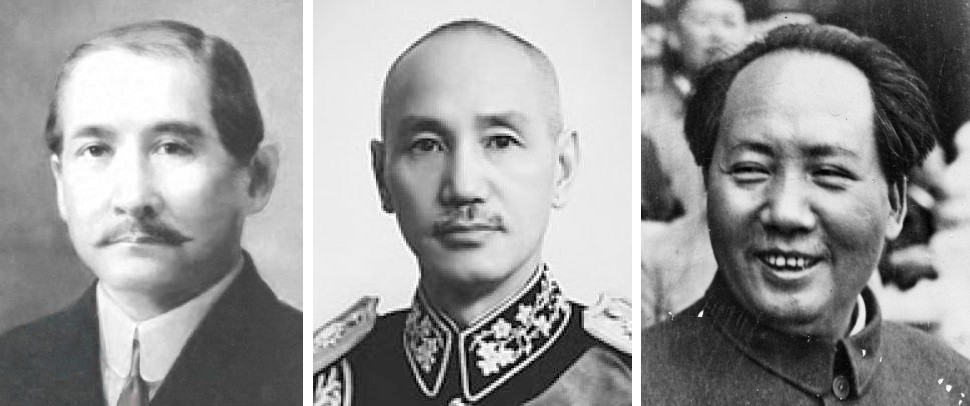
Sun Chiang Mao
Growing troubles on the Asian front. China, under the leadership of Dr. Sun Yat-sen, tried very hard to bring reform to China that resembled the “democracies” of Europe … presumably having proved themselves so strongly in the recent global war. But he died in 1925 … and it was all that his young replacement, General Chiang Kai-shek could do to keep ambitious regional warlords (rural Chinese) from trying to grab power. He was also facing Chinese Communists (largely urban-industrial Chinese), themselves deeply impressed by Western ways − at least those coming out of Lenin’s Russia. Little by little, Chiang and his pro-modernization Kuomintang (KMT) party managed to bring control to China, nearly destroying the Communist Party as well. But the young Mao Tse-tung (Mao Zedong) was able to lead a large number of surviving Communists on a “Long March” into the Chinese interior (1934-1935) to escape Chiang’s wrath.
But a bigger problem began to face China when neighboring Japan found itself in similar turmoil, Japan’s leadership (largely military in background) trying to move Japan also in a “Westernized” direction … while younger Japanese officers were anxious to turn Japan back to its much more aggressive social traditions under Shinto and its fierce bushido warrior ethic. Finally (1932) the younger group challenged the older leaders deeply when they grabbed China’s Manchuria province … forcing the Japanese leadership to have to decide whether to accept the prize – and greater Japanese militancy – or continue down the Western path. With a few assassinations of Japanese leaders soon taking place, the Shinto group ultimately took control. The emperor seemed to be in full accord with this development.
At this point, Japan was ready to exercise its vast military power any way it deemed necessary. An “anti-Comintern” (anti-Communist, though actually just anti-Stalinist Russia) Pact was signed by Japan with Germany in 1936 − then with Italy in 1937.
And then in July of 1937, Japanese troops in Manchuria simply invaded the rest of China – at least strategic coastal China – slaughtering hundreds of thousands of Chinese as they went.
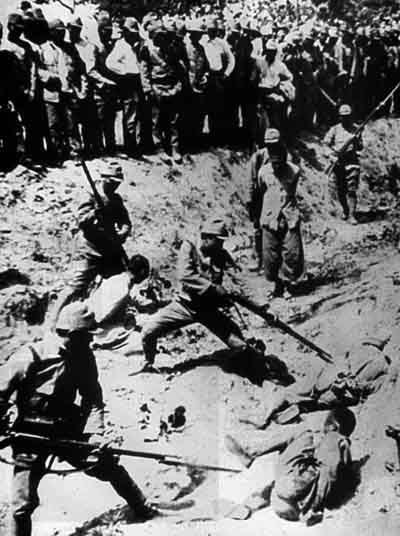
Japanese troops conducting “bayonet practice” on Chinese prisoners in Nanking – 1937
Leading a much smaller army, Chiang fought back as best possible. Chiang was finally able to halt the expansion of this Japanese occupation of China. But Chiang’s political base in urban China nonetheless found itself under full Japanese occupation – with little likelihood of the Japanese retreating from this position. Meanwhile, Mao continued to hide out in rural China, building up his forces in number there (Chinese farmers mostly).
Thus actually, 1937 was something of the true beginning of World War Two.
Stalin, and the Molotov-Ribbentrop Pact with Hitler. The ever-paranoid Stalin had grown suspicious of the officers of his own Communist or “Red” army … and in the period 1937-1939 he had countless officers executed − unverifiable numbers ranging from 700 thousand to almost 2 million. This of course left Stalin’s Russia very weak in the face of a very expansionist Hitler and his quest for Lebensraum.
But Stalin, believing himself to be a clever man, had plans of his own to turn the German urge westward, towards France, and maybe even England. In May of 1939, he replaced the pro-West Maxim Litvinov as the Soviet Russian foreign minister with Vyacheslav Molotov, an individual more willing to play the game of underhanded diplomacy. And thus he had the German foreign minister Baron von Ribbentrop come to Moscow in late August of 1939 to sign a treaty with Molotov, a treaty announced to the world as a peace agreement between Germany and Russia. The world was thrilled to hear the news.
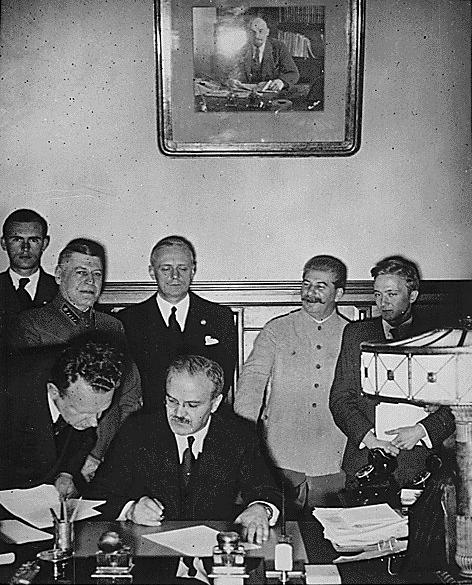
But what the world did not know was that the treaty included a secret part in which Russia and Germany agreed on a plan to divide Poland between them, satisfying some of Hitler’s hunger for Lebensraum … and thus giving Hitler the opportunity to then turn his hunger for conquest westward. And Stalin was most certain that this would quite foolishly plunge Germany into a war with France, and by association, Britain – a war that would, like the Great War, simply grind down all the warring parties, Germany, as well as France and Britain (and most likely Italy, presuming Mussolini to be stupid enough to get caught up in all this activity).
And with the ink on the treaty barely dry, only a few days later (September 1st, 1939), Hitler moved his troops unannounced into a shocked Poland. Two days later, when Hitler refused to pull back, Chamberlain declared war on Germany. France did the same. World War Two was now underway in the West.
THE WAR ITSELF
Sitzkrieg
An unprepared Poland was able to offer no serious resistance to Hitler’s invasion.
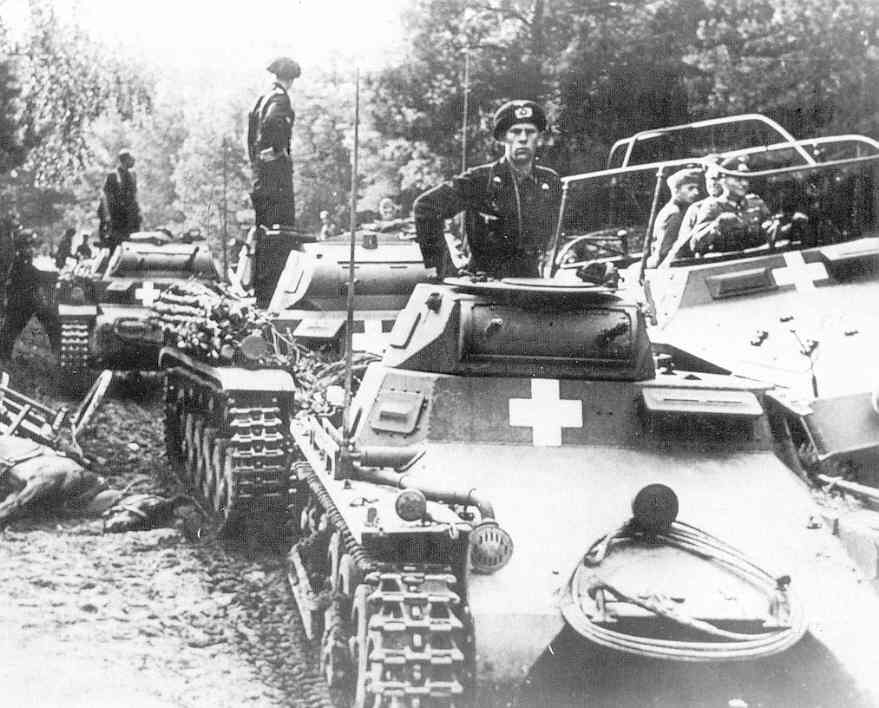
Then on the 17th of the month, Stalin sent his troops flooding into Poland, the Polish at first believing that they had come to help their fellow Slavs against this Germanic horde. But they were quick to learn that the Soviet Russian intent was the same as the German: to take over Poland.
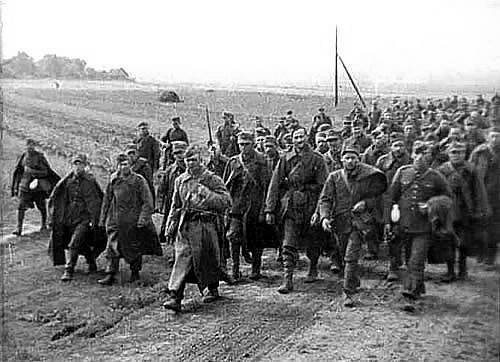
Polish troops captured by Stalin’s Russian troops – 1939
The response of Britain and France was pathetic. They did nothing –in part because they could do nothing. Getting troops across Germany to help the Polish fend off this assault by both Germany and Russia would have been impossible. And making an enemy of Russia would only have doubled their difficulties.
Then things got worse in the East as, per an agreement with Hitler, Stalin felt free to run over the defenseless neighboring Baltic states of Estonia, Latvia, Lithuania … and also invade another neighbor, Finland. Stalin was in a very expansive mood.
The issue of German and Russian imperialism was quickly brought up in the League of Nations. But talk – and the withdrawal of Russia from the organization (as already Germany, Italy and Japan had done) – was the only result.
The Finns fought hard, holding off Russia’s takeover of their country – until the effort simply collapsed early the next year (1940). Meanwhile, Britain sent its British Expeditionary Force (BEF) off to France. But ultimately France and Britain did nothing to put their declaration of war to good effect – not even hit Germany from behind (the Ruhr industrial area) while Hitler’s army was off absorbed in Poland.
In the end, Hitler mocked the inaction of his “enemies” designating their part of the war as conducting a Sitzkrieg (Sitting War) – in poetic contrast to his Blitzkrieg (Lightning War). Even cynical Brits call it a “Phony War.”
But for Churchill, newly appointed as the head of the British navy, this was no phony war – and sent his fleet out to protect Britain’s vital sea routes … and even take on (and have sunk) the German battleship Graf Spee.
The German assault on the West (April 1940)
By April of the next year, Hitler was ready to make that move in West Europe, first against Denmark (won in a single day) on his way to Norway, to secure passage in the north of Norway to “neutral” Sweden’s iron industry, needed vitally by Germany. The Norwegians put up a stiff resistance, and were never fully controlled, but lost out politically when a Norwegian politician, Vidkun Quisling, took power in agreement with Germany to bring his country officially under German authority.
Then in May, Hitler headed his troops towards France, butchered the Belgians who dared to get in his way, and even moved his troops into the Netherlands, despite Dutch efforts initially to stay neutral. And when the Dutch proved resistant, he smashed their cities to the ground (most notably Rotterdam).
As for France, he struck so quickly, concentrating his troops simply on a center point in the long French defense line, and was able to divide the French army into two disconnected units. With this, his troops took on the now-isolated eastern unit and quickly brought it defeat, and then turned toward the western unit.
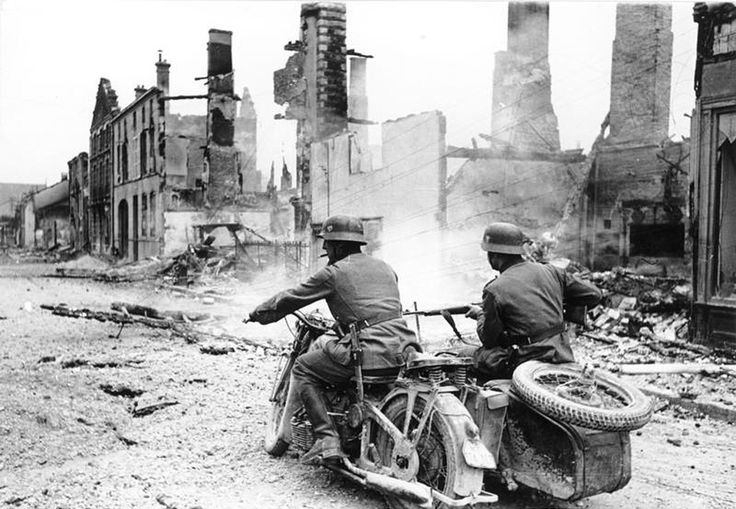
Except at that point Hitler seemed more interested in bringing the British to terms − to some kind of German-inspired understanding. The only problem was that British King George VI had replaced Chamberlain with Churchill, and Churchill made it clear that the only thing that interested him was the full defeat of Hitler’s Germany.
Worse for Hitler, in all this confusion, Churchill was able to get a huge trapped British army of 300,000 troops posted to France (and thousands of French troops as well) back across the channel from Dunkirk to England, to take up England’s defense.
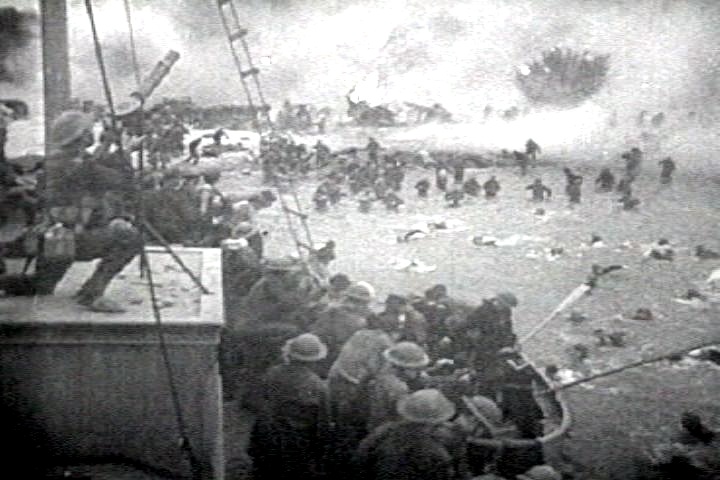
But then (as of the 22nd of June), with France’s sad agreement between Hitler and France’s new leader (and former World War One military hero) Philippe Pétain, a clearly defeated France was officially out of the war. Hitler consequently allowed the French living in the southern half of France to continue to live cautiously under their own government based at Vichy (thus “Vichy France”), presided over by Pétain. But Northern France, including Paris, now belonged to Germany.
At that point, Britain found itself to be the only West European country still standing against Hitler’s Germany.* But Britain’s Royal Air Force (RAF) proved able to bring down massive numbers of German planes, in what was now termed “the Battle of Britain” … the British able to bring pilots of their own downed planes back into service − the Germans not able to do so. Bit by bit, it was becoming apparent to an embarrassed Hitler that there would be no channel crossing for his Nazi troops. Thus he turned his attentions elsewhere (though the pointless bombing of English cities would continue).
Germany attacks Russia (1941)
In June of 1941, in an effort to grab the wheatlands of Ukraine and the oil fields of Azerbaijan located at the Caspian Sea − Hitler sent his forces against Russia, conducting Blitzkrieg against a very unprepared Russian army (despite Churchill’s warnings, which Stalin had ignored). Hitler’s forces moved quickly, but not as quickly as Hitler had hoped, because that spring they had been sidetracked with events going on south of their line of advance (in Yugoslavia) and had to deal with that first.
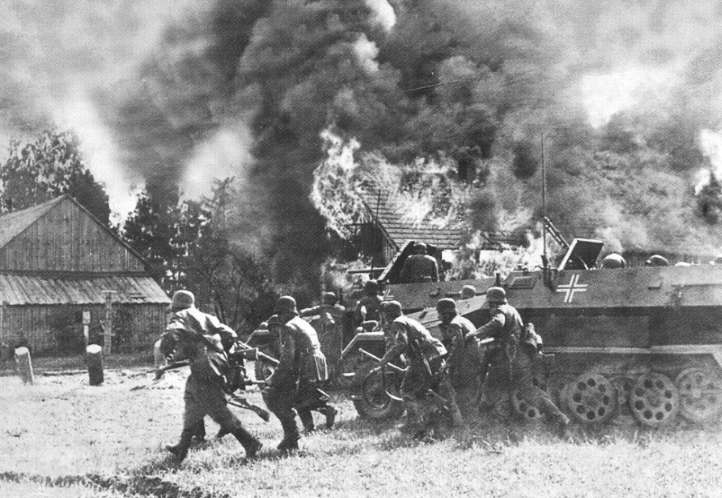
Stalin soon realized the need to switch his call from defending the “Socialist homeland” to simply defending “Mother Russia,” getting a much more dedicated response from the Russian people in doing so. And Hitler was about to discover how powerful such Russian (not Socialist) patriotism could be. Winter soon showed up, and the German offensive came to a halt. And then in the next spring of 1942 things resumed. Hitler’s troops were in fact finally able to reach the vital crossing point of Russia’s last line of defense at the Volga River, at the city of Stalingrad, before winter again brought things to a halt.
But at this point other factors played into the picture, and would help reshape the dynamic considerably.
And America?
What was America doing during this very dark time? Roosevelt’s hands remained tied diplomatically, but he did what he could to help out a besieged Britain. But Congress was no longer quite as insistent on a pacifist policy, and in 1940 jumped military appropriations from $2 billion to 10 $billion, and authorized the sale to Britain of military supplies, from millions of rounds of “surplus” ammunition to some 50 mothballed naval destroyers. By the next year (1941) Congress was ready to authorize Roosevelt, under a “Lend-Lease” program, to sell to Britain anything he deemed necessary to “the defense of America itself.” That program would soon include China and Russia as well as Britain.
The Atlantic Charter and the United Nations
Diplomatically speaking, an event of considerable significance occurred in August of 1941, when Roosevelt and Churchill met aboard the British battleship Prince of Wales, anchored just offshore from Canada, to go over an agreement concerning the goals of this war, a rather unusual thing to do since at that time America was not at war with anyone.

But this agreement was a very broad idea of what this war should be directed toward, not just winning a fight, but putting into play a world that lived by way of cooperation rather than conflict. No “pact” was signed, but the terms discussed were soon brought to the larger world, and numerous countries* came together in September in London to adopt those same terms of the agreement now known as the Atlantic Charter, and form a political union they termed the “United Nations.” This “United Nations” would actually also come to constitute a military alliance, one designed to bring an end to the empires of Germany, Italy and Japan.
The war in Asia, and America’s entrance into the war
America reacted increasingly strongly to Japan’s aggression in China, and finally in July of 1940 placed an embargo on the sale to Japan of American oil, iron, and other products needed by Japan to conduct its war in China (China refusing to quit). This eventually brought the Japanese leaders to the decision that they would need to expand their hold south to the Dutch East Indies (today’s Indonesia) to reach the oil there that they now needed so badly. In the process, they would have to knock out America’s ability to do anything about the matter. They would destroy America’s naval fleet in port in Hawaii, and also take the Philippines from the American grip in order to clear the path south to the Dutch territory.
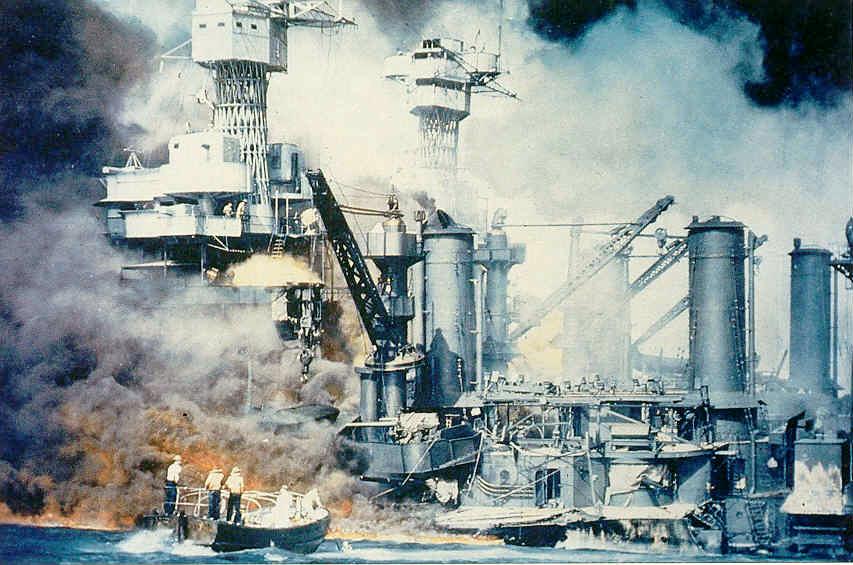
Thus, without warning, on December 7, 1941, Japanese aircraft struck Hawaii, sunk or badly crippled the American ships in port there (but they missed 4 aircraft carriers which were away from port on a training mission!), and destroyed the American airbase there as well.
However, instead of bringing America to its knees, as they supposed would happen to such a weak America, Japan aroused a “sleeping lion.”
The next day Roosevelt stood before Congress and got full authorization for war. He concluded his call:
With confidence in our armed forces, with the unbounded determination of our people, we will gain the inevitable triumph so help us God.
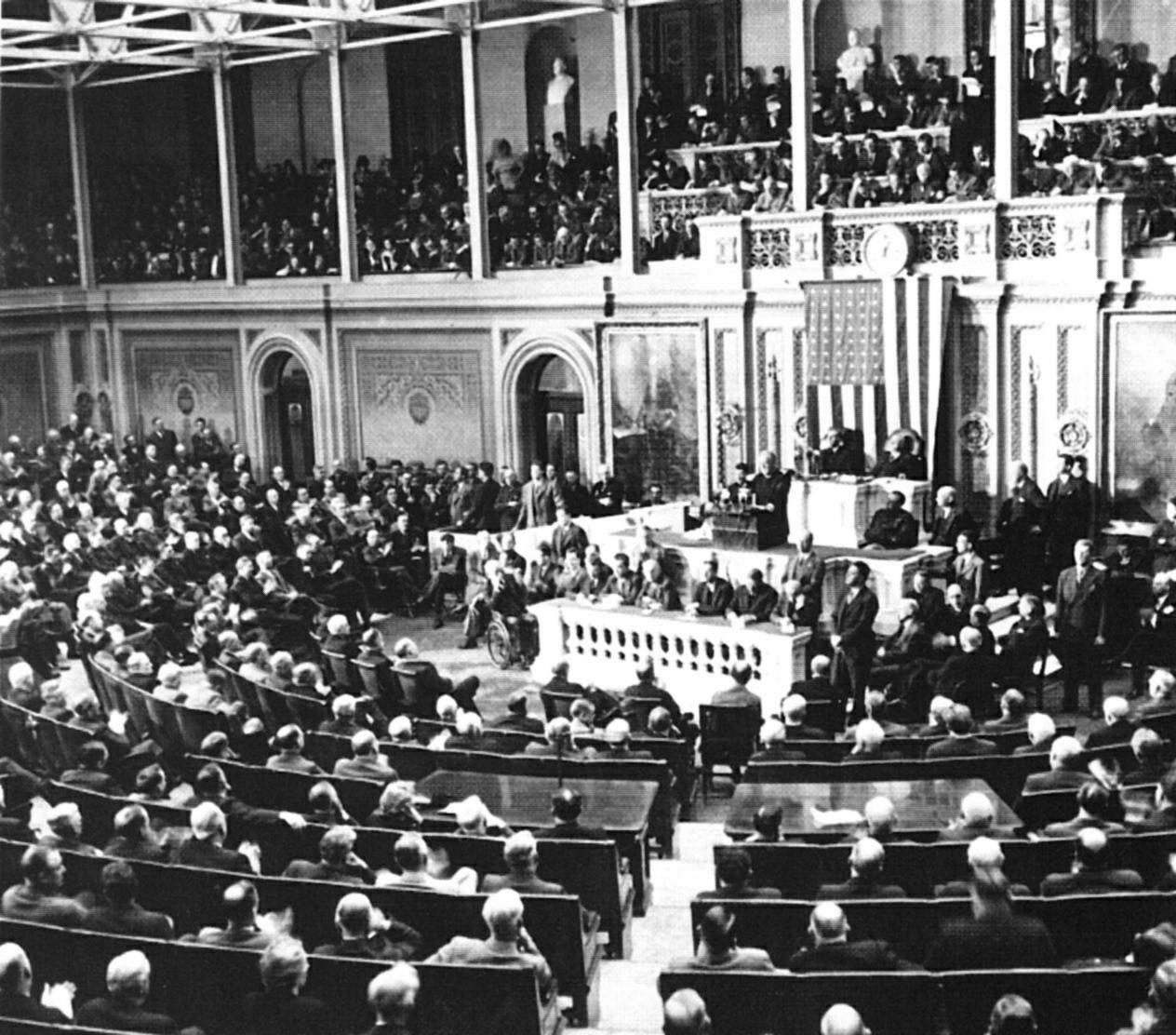
America was at war again, and would indeed get that help from God.
Then most foolishly, in order to “honor” his Axis treaty with Japan, several days later a power-drunk Hitler declared war on America! So America would thus be fighting a war on two fronts: in the Pacific, and now also in Europe.
Most amazingly, America quickly came out of its economic stupor, and cranked up its industrial economy again. The once despised capitalists took the lead in getting military production not only underway, but operating at an astronomically high rate.*
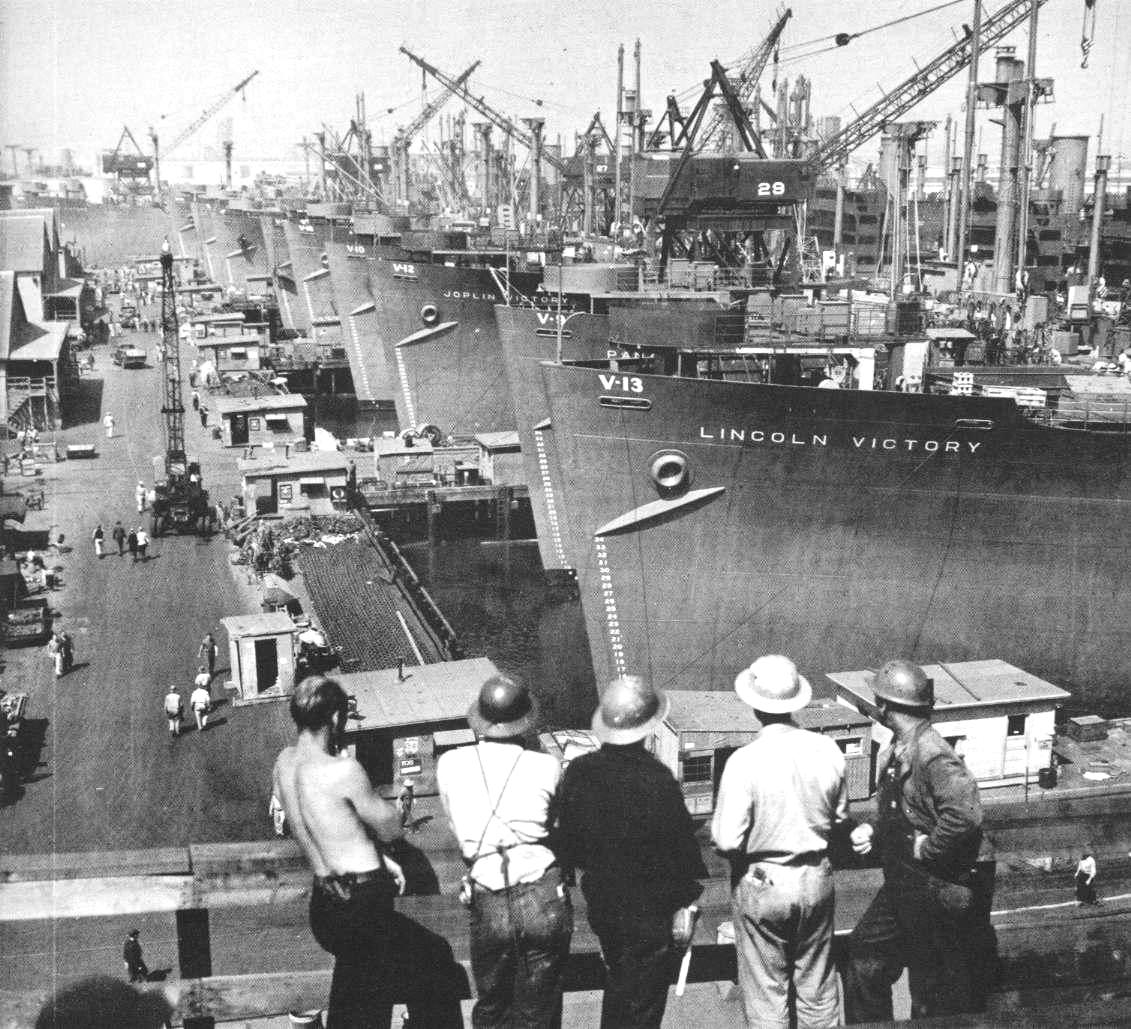
The war in the Pacific
The start was slow, with America’s naval fleet down and thus America unable to supply its troops based in the Philippines with needed resupply, and in May of 1942, the American troops posted to the Philippines were forced into horrible surrender.
But from that point on the war in the Pacific turned in America’s favor, quite quickly. A huge Japanese fleet headed in June to the strategic Midway Island was caught completely off guard when American carrier-based planes caught the Japanese by surprise. The engagement was disastrous for the Japanese, with the Japanese losing four aircraft carriers and over 300 of their planes. This truly crippled their navy.
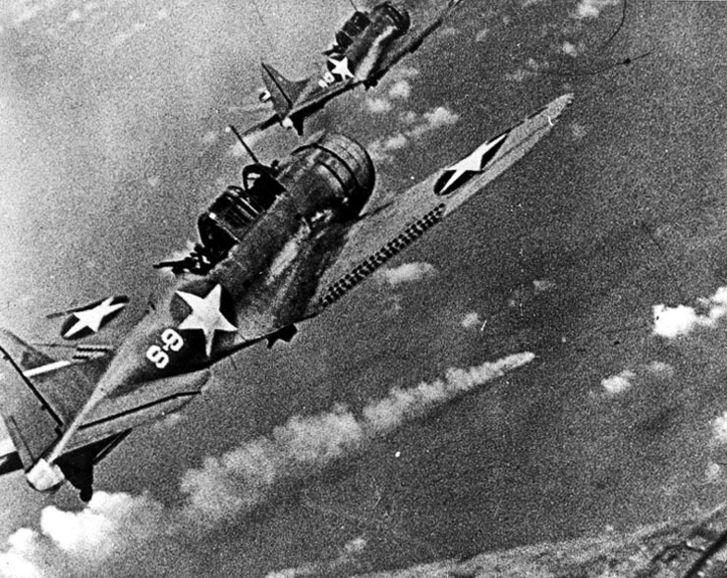
From that point on, Japan would be forced into retreat, as Americans captured island after island in the Pacific. And by early 1945, Americans had not only recaptured the Philippines, they had begun to capture outlying Japanese territory, principally Iwo Jima and Okinawa, despite the effort of the Japanese to defend their lands down to the last man, woman and child.
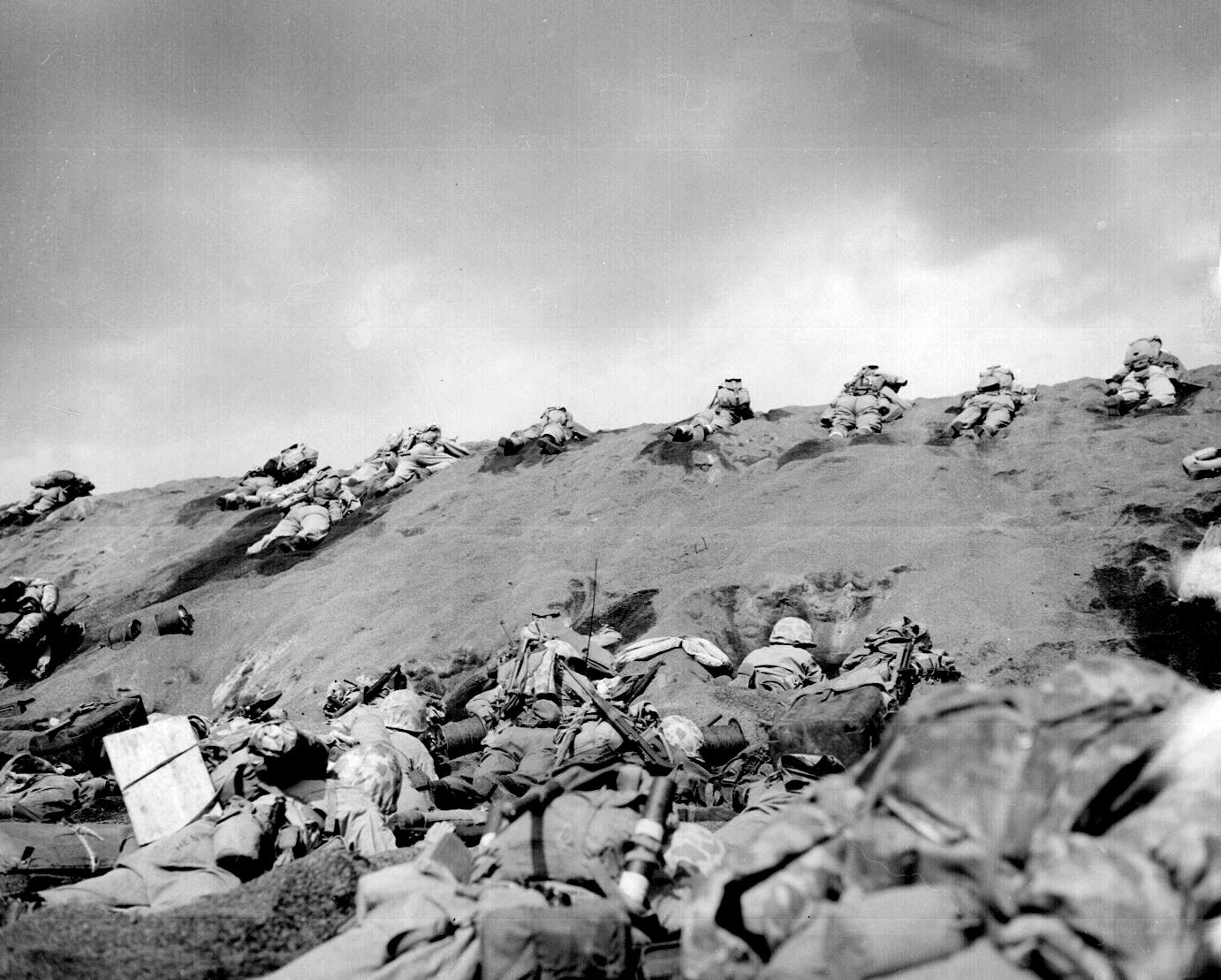
Marines begin their assault against the Japanese island of Iwo Jima – February 1945
Thus also at this point it appeared that defeating Japan itself in its own homeland was going to be a very bloody, very lengthy operation, perhaps taking two more years to complete, and costing millions of lives.
The war in Europe
The Mediterranean. Whereas the action in the Pacific was done largely under American direction, the war in Europe, well underway when America finally got drawn in, involved careful military diplomacy to get American, the British, and De Gaulle’s Free French to move together smoothly.
It was decided to have the Americans join the British in North Africa, the Americans advancing from the West (Morocco and Algeria) and the British from the East (Egypt and Libya) against the Germans and Italians based in North Africa (late 1942). The still inexperienced Americans at first stumbled a bit in coming into Tunisia (February 1943), but recovered and, with the British, then jumped to the Italian island of Sicily, and then moved on to the southern part of the Italian mainland.
In the meantime (July 1943) the Italians arrested and imprisoned Mussolini, and dropped out of the war (September). But the Germans would continue to hold on to Italy, with the mountainous terrain of Italy making its defense by the Germans easy for them, and any advance of the British and Americans extremely difficult. But by mid-1944, the British and American allies were half way up the peninsula, and the Americans were able to liberate the city of Rome (June) from German occupation.
France. Meanwhile, the attempt to come at Germany via France meant having to cross the English Channel, a difficult procedure, as a failed attempt in mid-1942 demonstrated most clearly. A lot of training, practice, and planned deceptions for the Germans got involved before the Allies were ready to make the crossing to the beaches of Normandy in early June of 1944.

From there they pushed ever-deeper into France. By the end of August, the Allies, plus the French Resistance, were able to liberate Paris, the Allies letting De Gaulle and his Free French lead the victory parade in Paris to ward off the attempt by the French Communists to make it appear to be a largely Communist victory.*
Russia. In the meantime (February 1943), Stalin’s Russian troops having stopped the Germans at Stalingrad (capturing a huge German army in the process), the Russians were now advancing westward against the Germans.
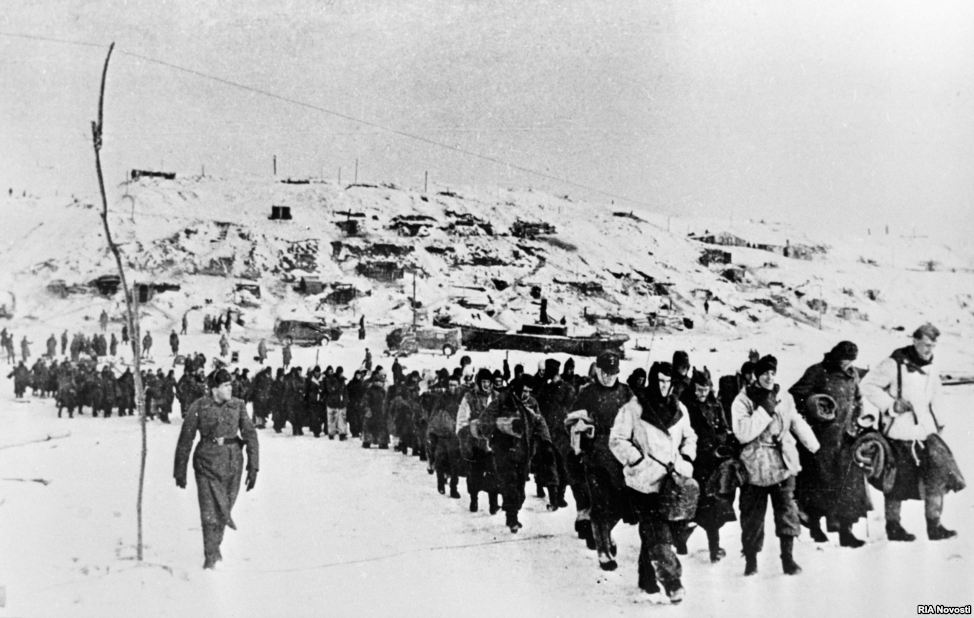
German troops taken prisoner at Stalingrad – 1943
In July of that year the Russians stopped a huge counteroffensive by the Germans at Kursk, in which thousands of tanks were used by both sides (the Germans 2500 tanks; the Russians twice that number). The Russians held, and Hitler halted German action, wanting to shift the German focus to Sicily, to stop the British and American offensive underway there. But this merely gave the Russians more opportunity to continue their advance against the Germans. Then winter set in, and it would not be until the summer of 1944 before the Russians were ready to resume their march.
By the end of August, the Russians had even advanced as far as central Poland. There they stopped, to let the Germans crush most cruelly a huge Polish uprising, the Germans serving Russia’s future political interests there by destroying Poland’s own Resistance, and much of the country itself. With the Poles crushed, the Russians then resumed their march in September, also swinging south to take control in the Balkans. Early the next year (1945), with fellow Communist Tito’s Partisans having already taken control in Yugoslavia, the Russians then swung north to attack the German ally, Hungary.
Advance against Germany in the West. Meanwhile on the Western front, an attempt by British and American troops in late 1944 to swing north from France into Belgium and the Netherlands, and then head from there into a supposedly weakly defended Northern Germany, failed to accomplish its mission. Instead, they ran into a strong German counteroffensive there. But the Germans were unable to support their advance, and found themselves in retreat in early 1945, with the Americans and the British coming into Germany itself from the West and the Russians doing the same in the East.
THE WAR COMES TO A CLOSE
The Yalta Meeting. With Germany clearly on the road to defeat, in February of 1945, Roosevelt, Stalin and Churchill met at the Russian Black Sea resort of Yalta, to go over the problems of how to oversee the rebuilding of a post-war Europe. As a result of the talks, it was agreed that Germany would be temporarily governed by the Russian, American and British powers in the areas where their armies found themselves to be when Germany surrendered. They would then see to the reconstruction of those zones, and then when completed, go home.
But also on the agenda was this matter of the war in Asia. With the war with Japan far from over, there was hope to bring Russia into the war as an ally, for up to that point, Stalin had seen no reason to get involved in the Asian portion of the war. But to bring him in, Roosevelt and Churchill agreed to give Stalin “administrative rights” to the huge northern Chinese industrial province of Manchuria, and also to the northern half of the Korean peninsula, America taking the same position in the south of Korea. At this point, Stalin promised that Russia would go to war against Japan within two or three months of Germany’s defeat.
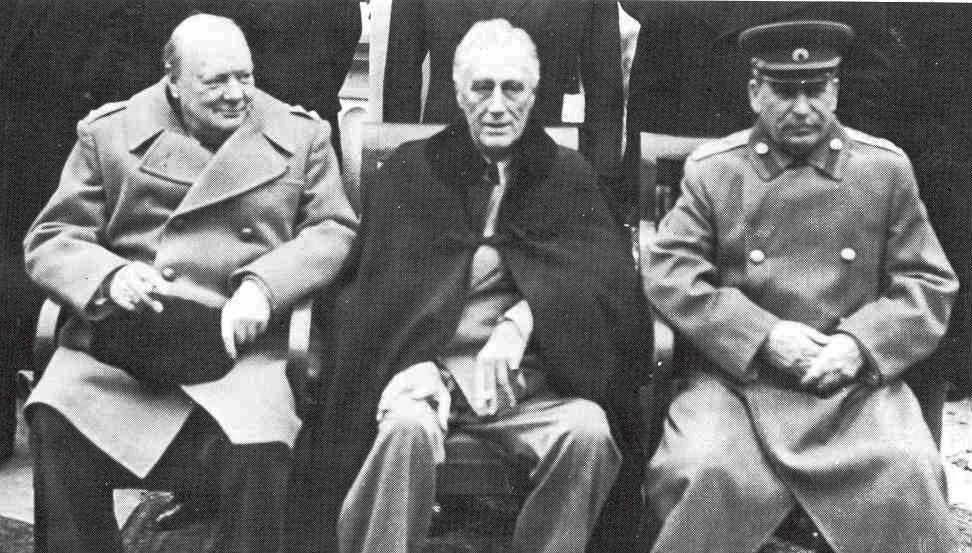
Roosevelt’s death (April 1945). At the Yalta meeting, Roosevelt appeared to be in very poor health, although little was said about the matter. Then in mid-April, America woke up to the news that their long-serving leader had simply died while at his health spa in Georgia.
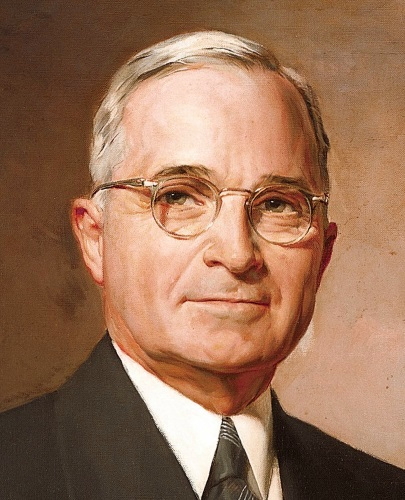 Truman. Taking his place was now his Vice President, Harry Truman. Who was he? Congress knew him well as a tough senator dedicated to ensuring that the massive financing of America’s huge war production stayed uncorrupt. But the public did not recognize him, Truman having just taken the position as Vice President merely three months earlier. And besides, the office of Vice President does not usually gain any public attention anyway.
Truman. Taking his place was now his Vice President, Harry Truman. Who was he? Congress knew him well as a tough senator dedicated to ensuring that the massive financing of America’s huge war production stayed uncorrupt. But the public did not recognize him, Truman having just taken the position as Vice President merely three months earlier. And besides, the office of Vice President does not usually gain any public attention anyway.
What America did not know was that this change in leadership was an amazing plus for America, because Truman was tough, wise, and an excellent judge of character. In this last matter, he was much better than Roosevelt, who seemingly had been taken in by Stalin’s charm, Roosevelt even deeply annoyed over Churchill’s distrust of Stalin. Needless to say, Churchill became greatly delighted when he came to realize that Truman was a quite different person than Roosevelt.
Just as Roosevelt came out of something of a “gentry” background, Truman definitely was a product of Middle America. He was born and raised on a farm in Missouri, and eventually found the military service he desired in the National Guard (he could not attend the U.S. Military Academy because of his poor eyesight). When America entered World War One, his own company elected him to be 1st lieutenant. He was then promoted to the rank of captain, and in charge of an artillery company, which he directed to great effect in destroying a German artillery unit that was about to unleash its fire on a vulnerable American division. After the war he would continue to serve in the reserves, as major (1920) and ultimately as colonel (1932).
His post-war attempt to start up a men’s clothing store in Kansas City ended in the economic setback of 1921. But his wartime friendship with the son of Kansas City political boss Tom Pendergast, gained him the position as county judge, encouraging him to then take up law studies on his own. The Democrat-Republican political swings back and forth also impacted Truman’s political position through the 1920s and into the early 1930s. But Pendergast was so impressed with Truman, and his personal integrity, that he put full support behind Truman in his run for the U.S. Senate in 1934 … an election that Truman then went on to win.
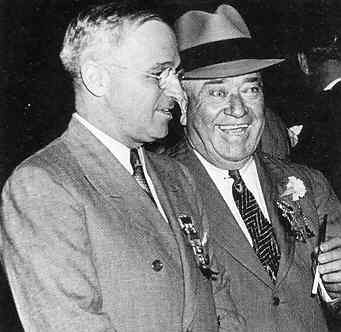
Truman and Pendergast
But coming into the U.S. Senate as a “Pendergast protégé” brought deep suspicion about Truman’s integrity on the part of his Senate colleagues. But Truman’s personal integrity began to show itself, and eventually he was able in early 1941 to create and chair a Senate subcommittee on military affairs, checking on army bases and their financial operations. Then with American entry into World War Two, his committee came to great importance in checking on the integrity of the massive financing that went into the war effort. His “Truman Committee” was recognized by war’s end to have saved the U.S. government some $15 billion in waste, even bringing Time magazine to place him on its March 1943 cover. And this is what inspired Roosevelt to select him to be his vice-presidential running mate in the 1944 national elections.

Personally, Truman was deeply shocked when he suddenly found himself now as U.S. president. He had played no role in presidential matters, and knew he was facing some very tough military-political decisions, not sure of how much support he might get from others in taking on those challenges. But he was one who had learned to push ahead with his responsibilities even when so little was originally expected of him. It was this firm resolve that would make him a great leader, even when the nation knew so little about what it was that he was up against.
And yes, he was a man of great Christian faith, although he kept such things to himself, believing strongly that such faith was never intended to be a matter of great public display.
Ironically, he would actually not come to be recognized as one of America’s greatest presidents until he was well out of office. But so it often goes for the truly great ones!
The end of the war in Europe. In any case, the American nation mourned deeply, and Hitler was delighted at the “act of God” (he truly saw it this way), presuming that this would reverse the course the war had taken during the past year. But it was not to be. The Germans were exhausted, Russians to the East were already up to the outskirts of Berlin, and the Americans and British in the West were already deep into Germany. And thus, at the end of that same month (April) Hitler took his own life. The German surrender then came within a week after that. The war in Europe was over.
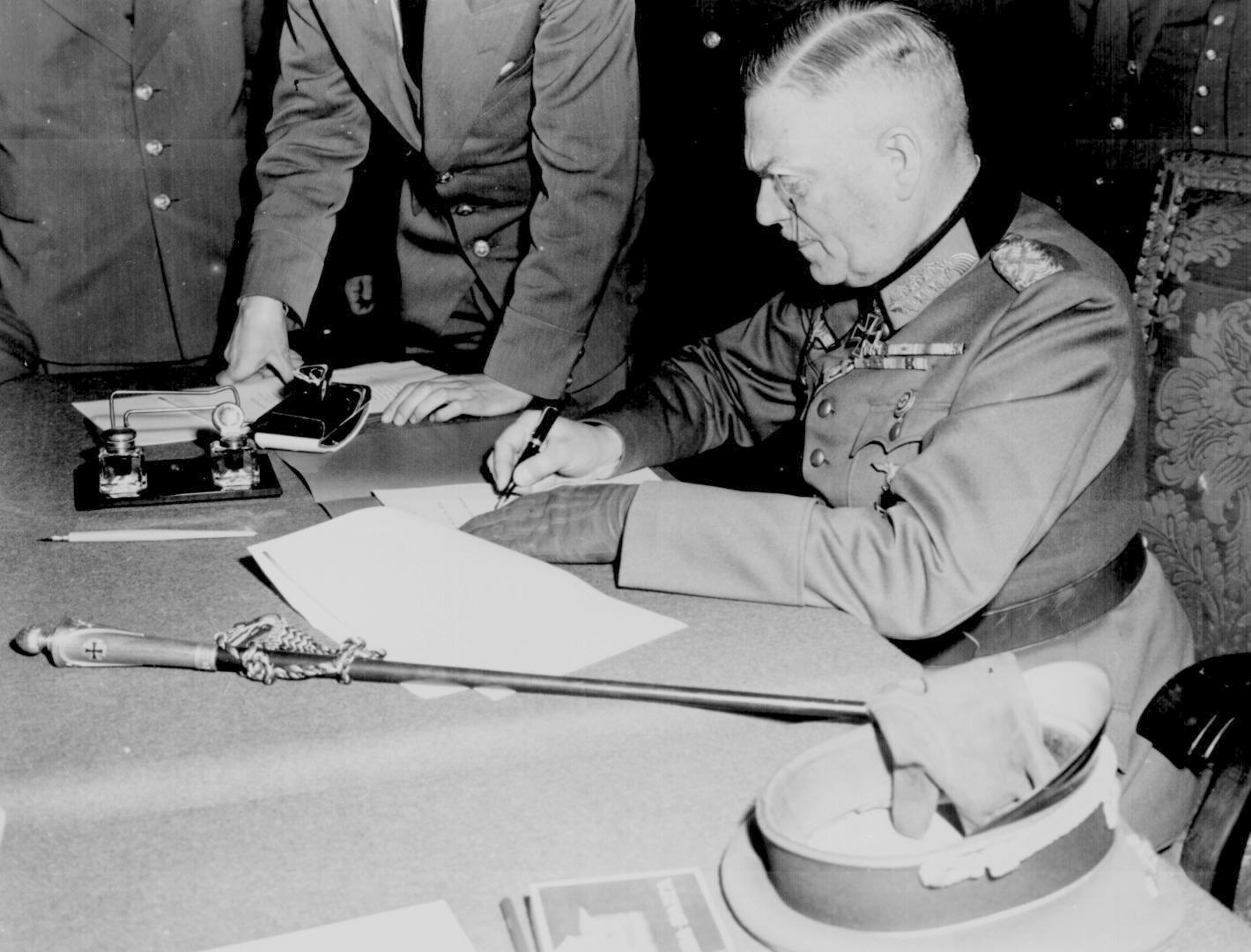
German General Keitel signs the surrender document – May 8, 1945
The meeting at Potsdam, and the end of the war with Japan. In mid-July, Truman, Churchill and Stalin came together in the Berlin suburb of Potsdam, to go over the details of the Yalta agreement, requiring two weeks to complete that work.

Truman and Stalin meeting at the Potsdam conference
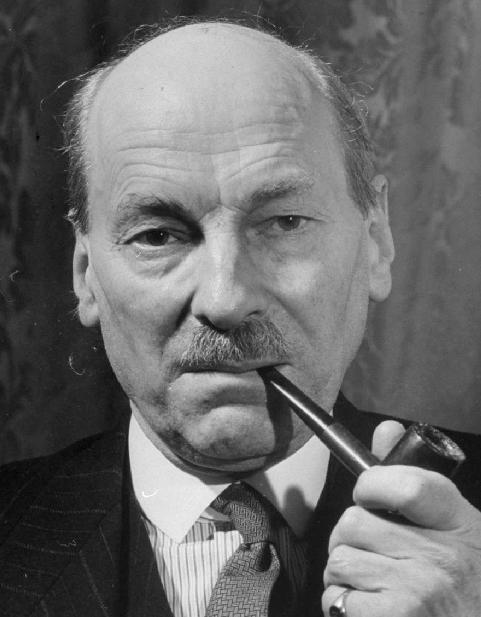 During that time, two amazing things happened. First of all, the British held their first national elections since before the beginning of the war, and voted Churchill out of power and Labour Party leader Clement Atlee into power! This was not only an unexpected pullback of support for the person that had kept Britain going during its darkest days, it brought to power a Socialist who was clearly more interested in domestic economic reform than in Britain resuming its international responsibilities after the war. That was just the point. The British did not care anymore about being a great international power. They simply wanted to go home and lick their wounds. But they would soon discover that Atlee’s Socialist instincts actually slowed down, rather than revitalized, Britain’s economic recovery.
During that time, two amazing things happened. First of all, the British held their first national elections since before the beginning of the war, and voted Churchill out of power and Labour Party leader Clement Atlee into power! This was not only an unexpected pullback of support for the person that had kept Britain going during its darkest days, it brought to power a Socialist who was clearly more interested in domestic economic reform than in Britain resuming its international responsibilities after the war. That was just the point. The British did not care anymore about being a great international power. They simply wanted to go home and lick their wounds. But they would soon discover that Atlee’s Socialist instincts actually slowed down, rather than revitalized, Britain’s economic recovery.
Secondly, aides quietly informed Truman of the news that the testing of America’s new atomic bomb had been successful. America was now in possession of the most terrible weapon ever conceived by man. When Truman then informed Stalin of this development, Stalin showed no reaction. This was either because it was his natural disposition to be that way, or because of pro-Socialist Americans working on the project who had secretly kept Stalin informed of developments in the matter.
However, at the time, Stalin was unimpressed with Truman, doubting that Truman would ever actually use such a weapon. Stalin, of course, would have had no such hesitation. And in fact, he had Russians working hard on a similar project.
But in this second matter Stalin was quite wrong. In early August, first at Hiroshima and then soon after at Nagasaki, two horrifying American atomic bombs were exploded, finally breaking the will of the Japanese.
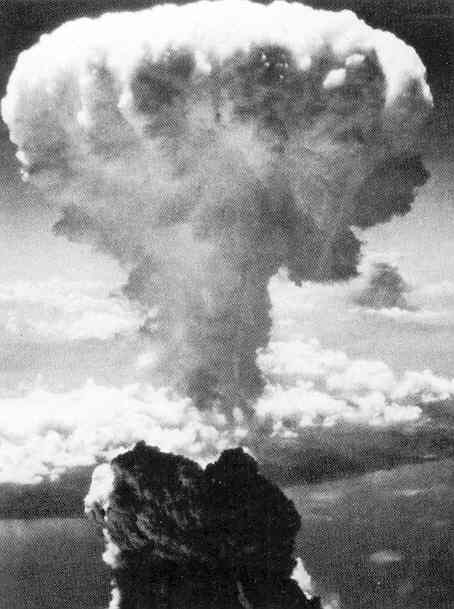
The atomic bomb dropped over Nagasaki – August 9, 1941
Stalin understood what this meant, and quickly declared war on Japan, in order to get the territorial reward he had been promised at Yalta. And indeed, a week later (mid-August), the Japanese accepted surrender.
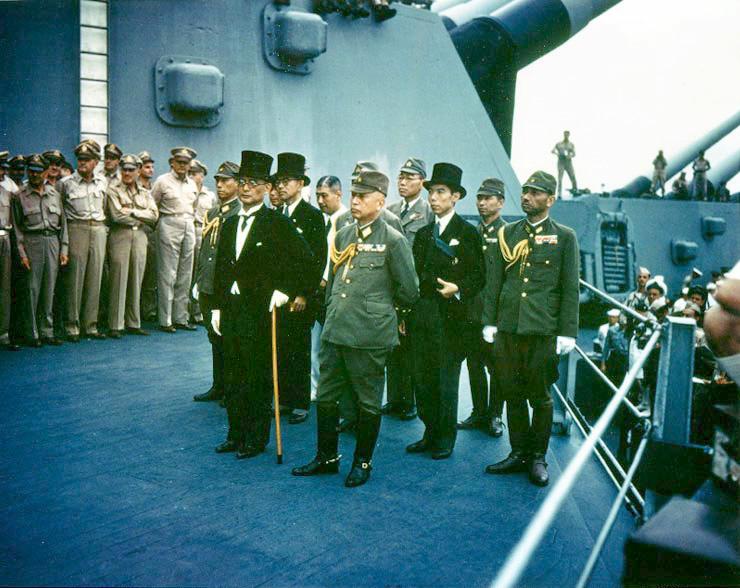
The Japanese surrender abord the USS Missouri – August 1945
And Stalin got all that promised territory. That was not bad for a week’s work, actually not even a week’s worth of work, because Russia had not yet really taken any new action against Japan!
In any case, World War Two was finally over.
POST-WAR AMERICA, AND ITS NEW RESPONSIBILITIES
Getting things back in place at home
The shaping of the “Vet” or “Greatest Generation.” Over 16 million Americans had served in the armed forces, 400,000 dying in service to the country and another 700,000 wounded or missing. These veterans, or “Vets,” as I like to term them, understood the importance of service to the nation, even to the world around them, finding deep personal meaning in that ability to offer such service to others.
They were, of course, unaware of how much such a strong sense of social morality was shaped by surrounding tough circumstances, ones deriving not only from the war but, as already pointed out, from the Great Depression before that. They had clearly developed an understanding of the great importance of working closely together to take on life’s challenges.
Also, they were most definitely “church goers,” in the habit of being instructed weekly from the pulpit about the importance of going at things with God in Jesus Christ. Consequently, this very strong social “instinct” of theirs was shaped deeply by a sense of Christian spirituality, seeing a very active hand of God in leading them forward against life’s immense challenges.
Unfortunately − very unfortunately in fact − such a social or moral Christian worldview now seemed so natural to them that they supposed they were just instinctive to all people. In any case, with the war over, they were ready to get home, and make up for lost time socially, having put off events that had to await the end of the war. Quite naturally the demands of military service had delayed marriages of millions of young Vets. But once the war was over, marriages abounded, and by mid-1946, a “Baby Boom” hit America.
However, these young Vets would now also be looking for work in an economy that was no longer involved in the limitless production of war goods or in the extensive bureaucratic management of U.S. military operations. With much lower production or supervision needs, workers and employees were let go, to join the recently demobilized soldiers. Jobs at the time therefore were scarce, setting up just the right conditions for the kind of labor militancy that was shaking Europe. Indeed, in the first year after the war, some five million Americans found themselves unemployed and even on strike.
Thankfully they had one wonderful alternative working for them: the G.I. bill. This piece of Rooseveltian legislation offered very low interest-rate loans to veterans wanting to go to college, to buy a house, or to start up a business of their own. And Americans, still being very self-sufficient by cultural nature, took up just such offers, helping immensely in getting their world back in production, back in good order.
Middle America back in business. And there was the wisdom of the Marshall Plan (more about that below), which awarded billions of dollars to the Europeans to redevelop their war-torn economic infrastructures, much of that money used to buy industrial goods still being produced by an American industrial world untouched by the war. By 1948, the Marshall Plan actually meant jobs for Vets, lots of jobs.
And there was great consumer hunger in America itself to get new cars and to have housing neighborhoods built … in massive numbers. And thus business in America on the basis of its own needs was explosive.
Now, jobs for everyone, good jobs at that, in turn did what the 1930s had not done: usher industrial workers into middle class American life, as they got that car, as they got that house in the suburbs. Thus worker militancy turned fairly quickly into Middle American loyalty, on the part of a Vet generation already well trained by the war in the importance of such social loyalty.
Dealing with the larger postwar world
Strategic challenges. Truman knew full well that the general expectation of Americans was that, with the war finally over, the boys in uniform would now be coming home. But Truman knew that there were serious problems abroad, ones that merely would worsen greatly if America simply pulled out of the larger international political realm. Truman and America had a job to do, to take the lead, at least in terms of what was going to happen to that part of Europe and of Japan where American troops were strongly positioned.
Germany (and Poland). As detailed at Yalta, Germany was carved into three zones by way of military positions at war’s end of Russia, America, and Britain … with France then added − simply by giving France sections of the American and British zones to administer. Also by the Yalta agreement, the capital city Berlin was similarly divided into occupation zones – even though it was located entirely within the zone of Russian occupation.
But Germany itself was reshaped, in that Poland was restored to independence – but only the portion that Germany had grabbed. Russia simply absorbed the eastern half of Poland that the Molotov-Ribbentrop treaty had awarded to Russia. And Stalin was in no mood to give up that land. And America, Britain and France were in no position to challenge Stalin on this matter. As a consequence, when it began to dawn on the Poles living in the Soviet-occupied eastern portion of their country, they began to abandon their homes and head west.
But Stalin was willing to be generous to Poland – at least to the extent of carving out a huge portion of eastern Germany itself and handing it over to Poland … as if that were some kind of compensation for his own Poland grab. Consequently, Germans in mass numbers now also joined the trek west, to get away from the new arrangement.
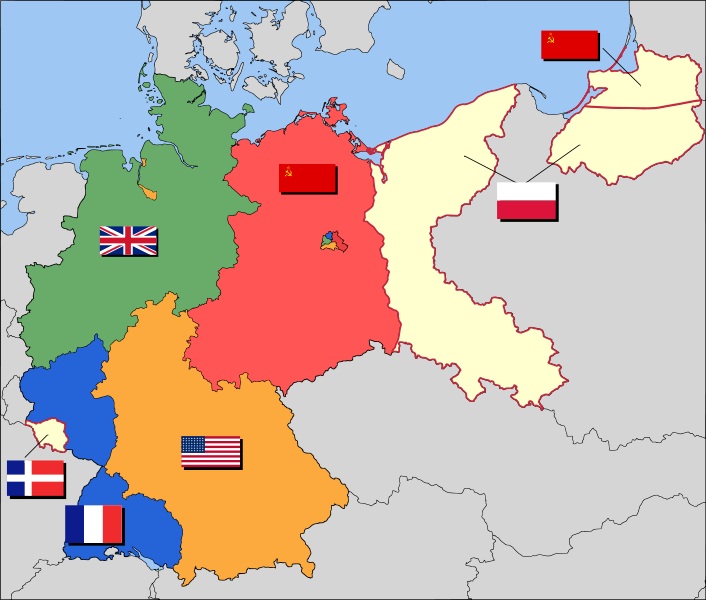
A map (Wikipedia) showing the occupational division of Germany in the West and the actual loss of German territory (yellow) to Poland and Russia in the East
Consequently, post-war continental Europe found millions of its citizens now ranked as DPs – “Displaced Persons.” It was a very tragic time.
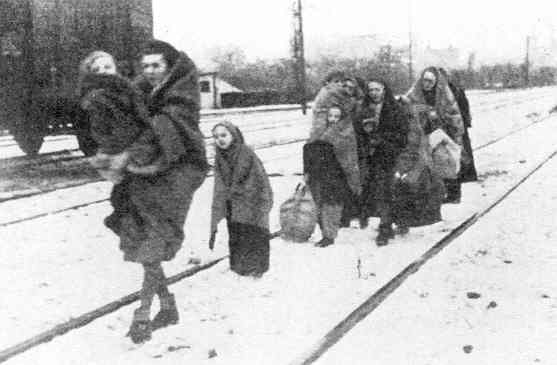
German refugees from Poland
Japan. Since Russia had played no role in the war with Japan – and Britain found itself deeply preoccupied with domestic matters – things were left pretty much to America to oversee post-war Japan. Most wisely the decision was made to keep the emperor in place as such – but (under his own agreement) not as a Japanese god but simply as their “democratic” leader. But that leadership was to be shared with American General MacArthur, as if Japan had two emperors! But the two worked well together, and consequently Japan experienced a fairly quick post-war recovery.
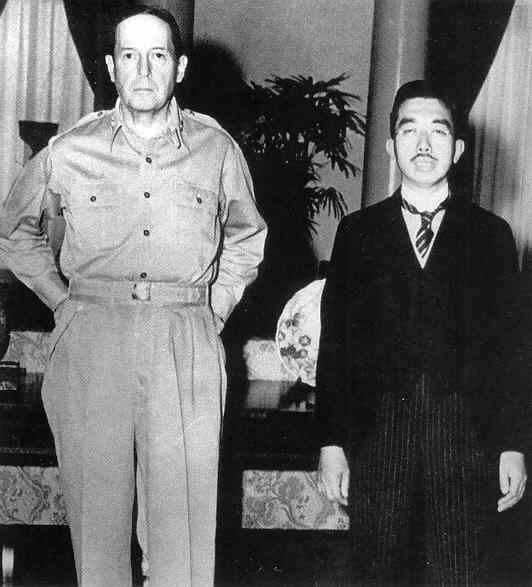
General Douglas MacArthur and Japanese Emperor Hirohito
West Europe. With respect to continuing American responsibilities in Europe itself, those were vastly more complicated. In that area, America was clearly looked to for leadership, because America’s wartime allies in the West of Europe found themselves deeply preoccupied simply with the urgent need to rebuild their own societies. They would have little or no ability to play their former roles as world powers, at least for a while.
France, for instance, was divided deeply between the French nationalists moving under De Gaulle’s leadership, and the equally numerous French Communists ready to continue to work under Stalin’s direction. And trying to hold the new French 4th Republic together was only a very weak French coalition of centrist parties, although at first the French Communists were told by Stalin to be a part of that coalition. De Gaulle’s group refused to compromise, and served as an opposition party.
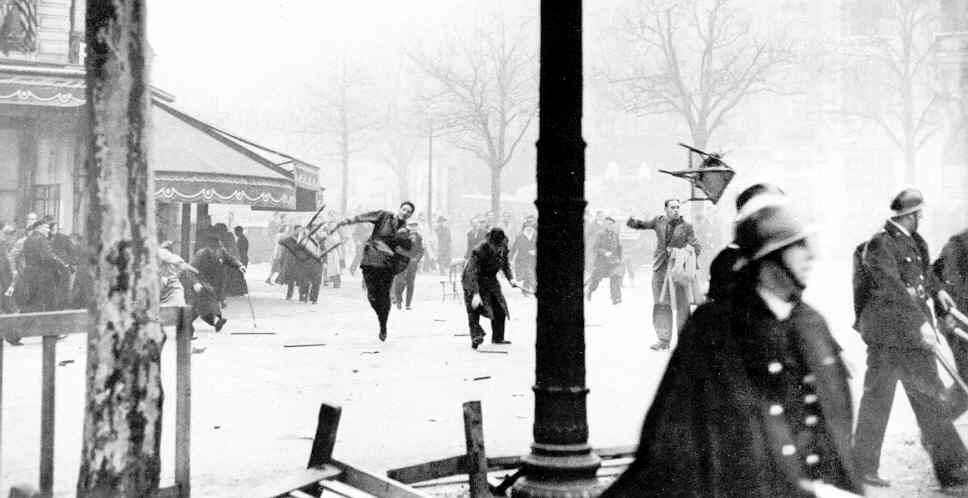
Communists attacking police in Paris – 1948
And Britain, now under Atlee and his Labour Party, was more than ready to abandon the larger interests abroad of its once mighty British Empire. Instead, Atlee was focused rather intensely on putting his Labour Party’s Socialist program in place in Britain itself, nationalizing the country’s railroads and major industries, supposedly in order to get an orderly (and more pro-worker) British economy back up and running. Tragically, by undercutting Britain’s own considerable entrepreneurial spirit and putting it under the direction of government bureaucrats, he took the thunder out of the British economy. And sadly, because of this Socialist or bureaucratic approach to economics, Britain would find itself recovering economically much more slowly than the rest of West Europe.
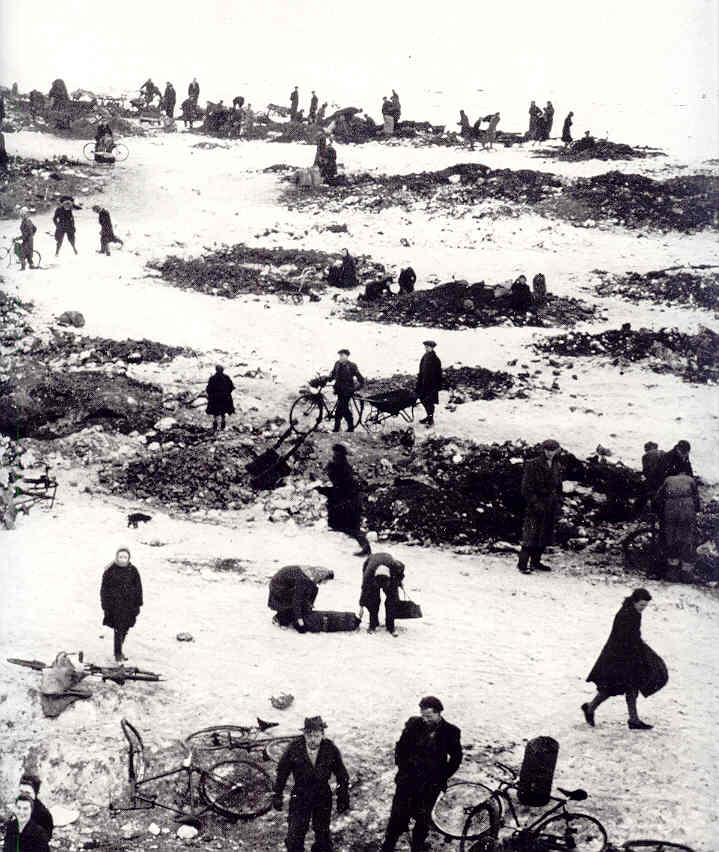
Brits looking for fuel – 1947
India. Basically it was Truman’s policy to stay out of other international developments, if they did not directly affect the political game being played in Europe. Thus for instance, America did not involve itself in Gandhi’s move to get Atlee to let India be on its own way as a newly independent nation, even when it all turned into a monumental disaster, with Gandhi himself killed in the chaos.
Palestine. The same held true when chaos erupted in British Palestine, when European Jews flooded the region, in the hopes of never going through again what had just happened to them. They hungered for their own homeland.
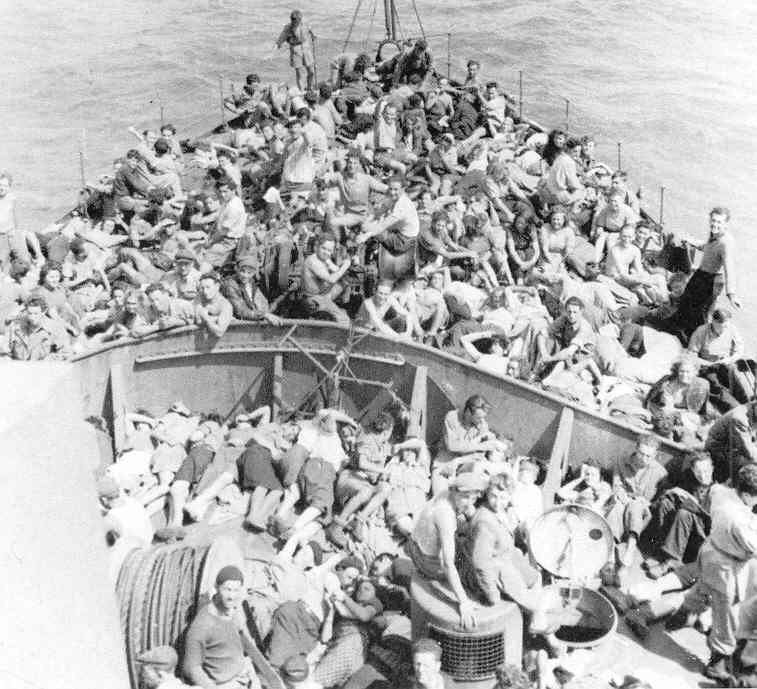
The only problem was that Palestine, where they intended to plant their new Israel, was fully inhabited, by Muslims, Christians and even Jews. Here too, Atlee simply pulled out of the region to leave matters to the locals. Some 700,000 Palestinians finally ended up in desert-based refugee camps, pushed there by Jewish forces in order to make way for the incoming flood of European Jews.
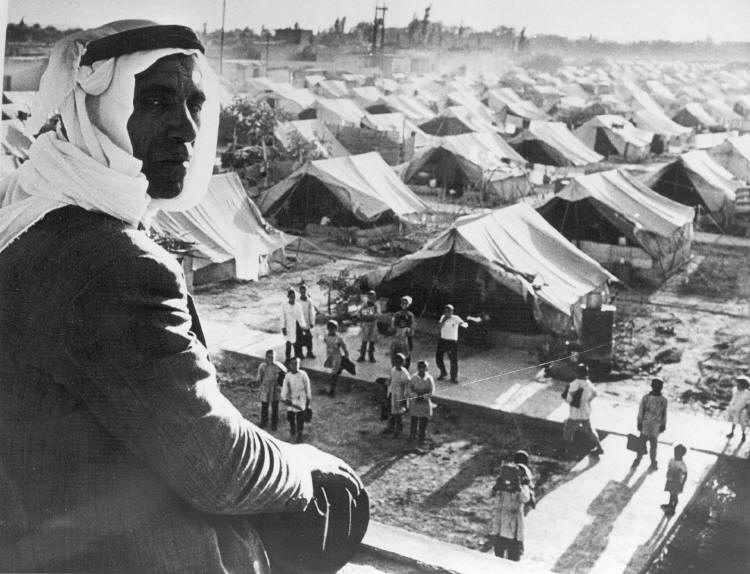
A Palestinian refugee camp in Syria – 1948
And this would be the beginning of an ongoing feud between the new Israel and the surrounding Arab world, the latter feeling it imperative to support their fellow Palestinian Arabs. Again, America chose to stay out of this mess, for the time being, anyway.
Indonesia. However Americans did lean on their Dutch friends, when the Dutch tried to return to their 300-year-old colony of the Dutch East Indies (today’s Indonesia). Considerable international pressure, even coming from America − which cut off all Marshall Plan aid (more on that below) designed to rebuild the Dutch position in the East Indies, even threatening a similar cutoff of aid to the Netherlands itself if the Dutch did not cooperate − was aimed at the Dutch to get them to end their “imperialism” in Asia.
Vietnam. In French Indo-China, the Vietnamese leader Ho Chi Minh was hoping to get similar “anti-imperialist” aid from America, especially after having worked closely with America during the war against the Japanese. But the issue dragged on, and the fact that Ho was an acknowledged Communist (he had even participated in the setup of the French Communist Party back in 1920) had at this point (the later 1940s) become a huge problem in American thinking. Consequently, he got no support from a cautious Truman, with the French by 1949-1950 actually getting American support, although not in a big way. Beyond that, America here too largely stayed out of developments in French Indo-China, at least for a while
Mao takes over China. General Marshall was sent by Truman to China in late 1945 to try to get Chiang and Mao to work together.
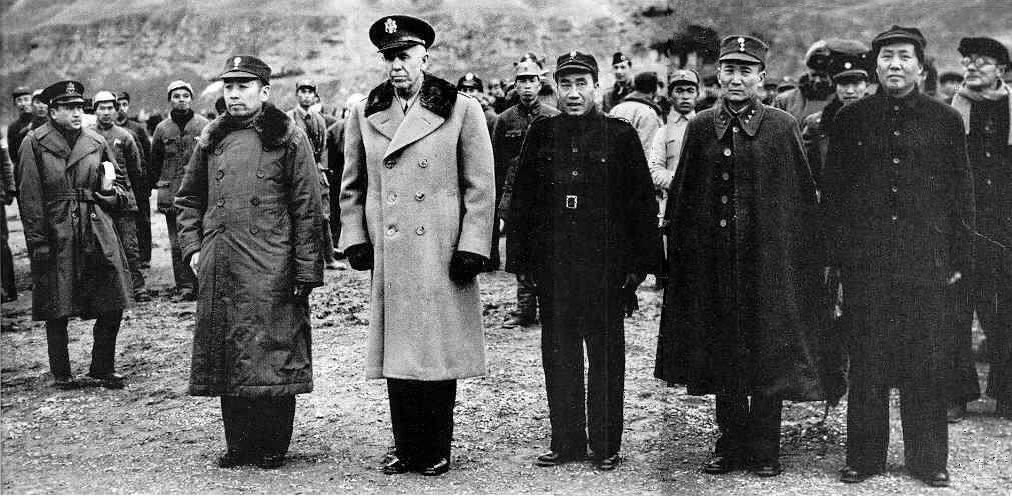
Marshall meeting with Mao (right) and some of Chiang’s representatives – 1945
But he got nowhere in the effort and in early 1947 Marshall left China to take up his position as Truman’s Secretary of State. America did what it could to supply Chiang with arms, but that came to little. Mao was able to build up a huge army of largely farm workers, to take on Chiang’s postwar urban world, a world not doing well economically and spiritually because of the lengthy Japanese wartime occupation of coastal (urban) China. Little by little Chiang lost ground, until in early 1949 he simply escaped, along with two million fellow Chinese, to the huge island of Taiwan just to the East of the Chinese mainland. Other than sending military supplies to Chiang (just as Stalin was sending such supplies to Mao), Truman chose to stay out of the conflict.
Nonetheless, with Mao’s victory, America would continue to recognize Chiang as the “legitimate” ruler of China (even if the only part of China he realistically governed was Taiwan), and used its U.N. veto to keep the Chinese chair on the Security Council from being turned over to Mao’s government.
“CONTAINING” SOVIET EXPANSION IN EUROPE
Truman was quite aware of Stalin’s intentions of taking advantage of its wartime allies, the latter exhausted from the conflict and most willing to go home and tend to their domestic wounds. Truman knew that a paranoid Stalin hungered to find inner peace − by making the threatening world to the West (a Russian problem since Czarist times) come under as wide a Russian control as possible. He would take every opportunity he could, whether military (as in Russian-occupied East Europe) or political (through his supervision of the massive Communist Parties operating in West Europe), to secure that control.
But the rest of America was not so alert to these Stalinist challenges, still seeing Stalin affectionately as “Uncle Joe Stalin” … a warm figure necessitated by wartime propaganda. He was hardly democratic, so what else was there to go on to make him “legitimate” as an ally in this great crusade for democracy – as Americans once again saw the war?
Thus America was shocked – even outraged − when in April of 1946 Churchill visited America, and in Truman’s hometown of Independence, Missouri, delivered a most unexpected speech. In this address, he warned America about Stalin’s dictatorial intentions in the eastern half of Europe – in countries lying behind an “Iron Curtain” that divided Europe, East and West … and how Stalin also had intentions to dominate as much as possible life in the western half of Europe as well.
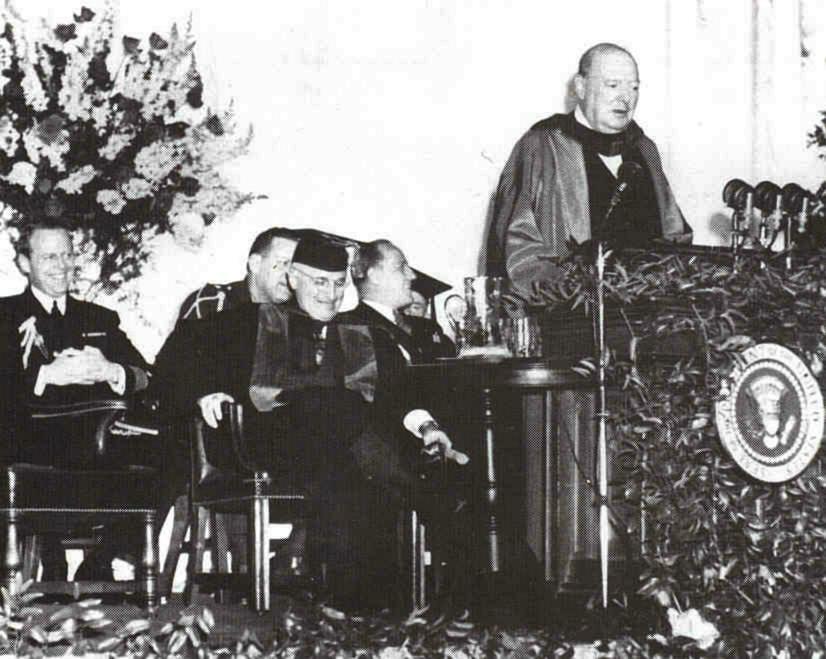
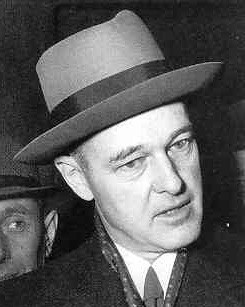 Actually for the U.S. State Department, no such shock occurred because Truman and his presidential advisors were already working on the problem Churchill described, thanks to a “long telegram” sent to Washington from Kiev earlier (February 1946) by the State Department’s George Kennan, who explained quite clearly Stalin’s program, and called for the “firm and vigilant containment of Russian expansive tendencies.” Thus the doctrine of Russian “containment” was birthed.*
Actually for the U.S. State Department, no such shock occurred because Truman and his presidential advisors were already working on the problem Churchill described, thanks to a “long telegram” sent to Washington from Kiev earlier (February 1946) by the State Department’s George Kennan, who explained quite clearly Stalin’s program, and called for the “firm and vigilant containment of Russian expansive tendencies.” Thus the doctrine of Russian “containment” was birthed.*
A crisis in Iran that developed at war’s end – which Americans knew very little about – had already put America and Russia at odds with each other. Iran had been used as an avenue for moving war goods to Russia during the war. And by agreement, Russia and its allies had agreed to pull out of Iran at war’s end. But Russia had not, and had helped set up two Communist regimes in northern Iran. Truman brought the matter to the new United Nations – and Stalin finally backed his troops out of Iran (April 1946) – and the two Communist regimes soon fell. But this left Stalin determined to never again fall under U.N. pressure. He had a veto to use against unwanted U.N. decisions − and he would use it constantly.
The Truman Doctrine. By the following year (1947) it had also become quite clear to Congress that action needed to be taken. Even Senator Arthur Vandenberg − once the Republican Party’s leading isolationist − was now a most vocal supporter of American action abroad. Thus Truman was able to get Congress to authorize what would come to be known as the Truman Doctrine … to come to the aid of Greece, under the threat of a Yugoslav-supported Communist takeover of the country, and Turkey, under pressure from Stalin to bring under Russian control Turkey’s strategic Dardanelles Straits linking the Soviet navy based in the Black Sea with the vitally important Mediterranean Sea. And with that American support, both countries were able to block Communism’s takeover of their countries.
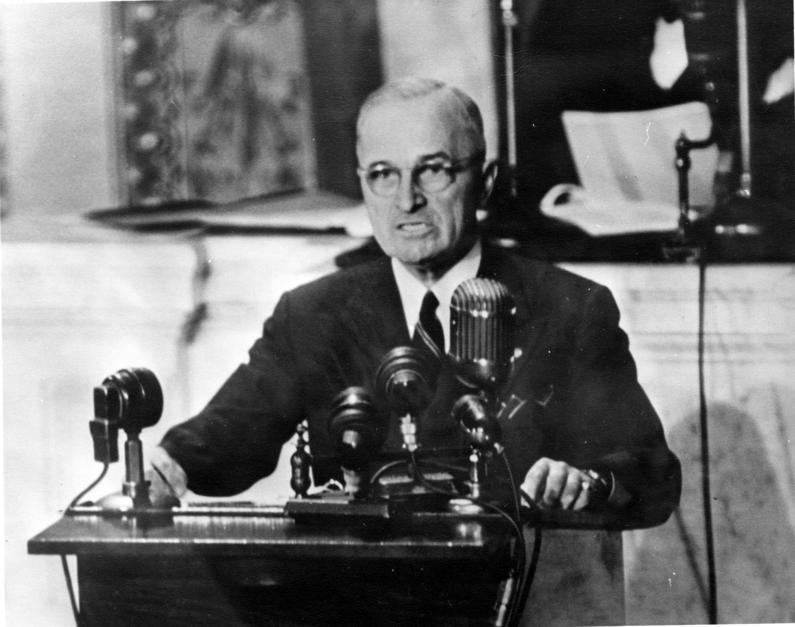
Truman presenting his “Truman Doctrine,” aiding Greece and Turkey – March 1947
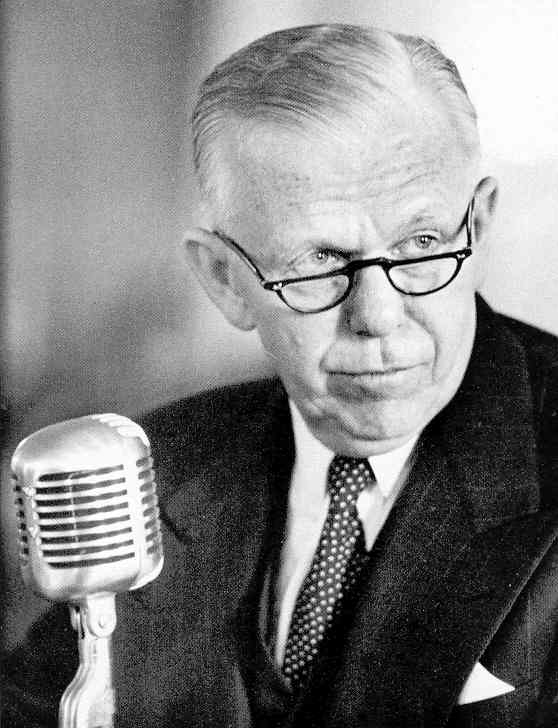 The Marshall Plan. At the same time, Truman, through his Secretary of State George Marshall, got Congress to agree to fund European societies in danger of economic collapse. Helping them get back on their feet economically would undercut greatly Communism’s appeal in those countries. Thus the Marshall Plan was born.*
The Marshall Plan. At the same time, Truman, through his Secretary of State George Marshall, got Congress to agree to fund European societies in danger of economic collapse. Helping them get back on their feet economically would undercut greatly Communism’s appeal in those countries. Thus the Marshall Plan was born.*
The offer actually extended even to Soviet Russia, and certainly to the East European countries under Russian occupation as well. Needless to say, Stalin was hardly inclined to accept such Marshall Plan aid, nor would he allow those countries located “behind the Iron Curtain” to do so.
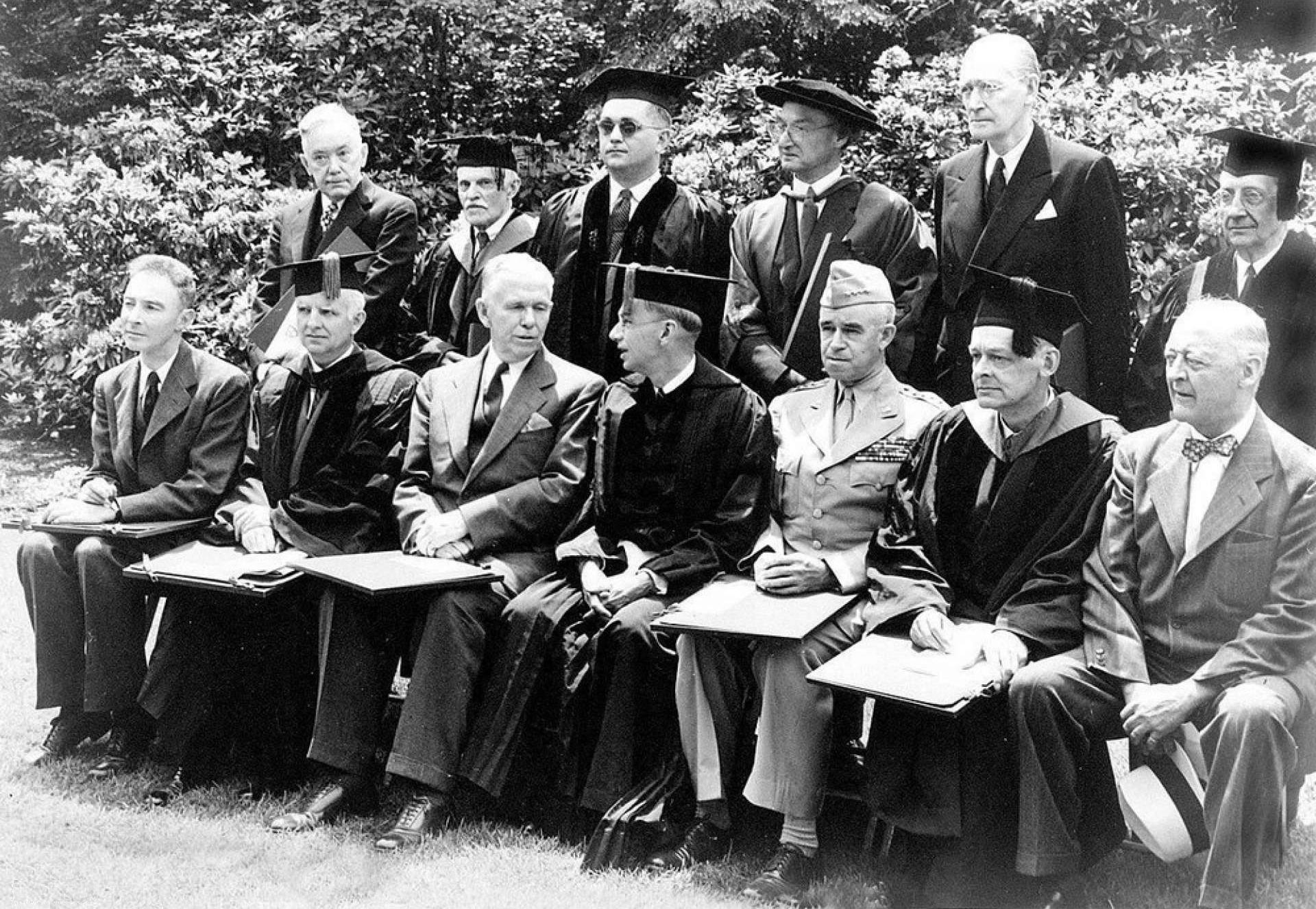
Marshall at Harvard … about to announce the new European Recovery Program (the “Marshall Plan”) – June 1947
In any case, thus it was that $12 billion was awarded to Western societies over the next few years (and billions more after that) for the rebuilding of their homes and cities, supplying them with much-needed equipment for the running of their farms and industries, etc. And indeed it all had exactly the desired effect. Stalin’s plans for control in West Europe got blocked – blocked fully.
Prague. Czechoslovakia found itself in something of a neutral position in this East-West drama, Russian and American military forces having pulled out of the country at the war’s end. But elections were coming up in 1948, and local Communists were already in the streets calling for a “working class” victory. Then the leader of the pro-Western group, a group eager to accept Marshall Plan aid, was found dead. In the confusion, the Communists were able to take over the national police, begin arresting opponents, and finally take over the whole government. For Americans watching this event, this was the ultimate eye-opener as to the dangers that Communism posed to a “Free World.”
Berlin. At the same time, Stalin was greatly annoyed about this embarrassing Western presence in Berlin − in the midst of his now-Communist “East Germany.” He wanted the Westerners gone. So he shut down the railways and highways leading from West Germany into Berlin “for repair.” Truman responded quickly by expanding air travel into Berlin − knowing that Stalin dared not shoot down one of his planes. An act of war against an American president known to be willing to use nuclear weapons was not part of Stalin’s program. But Stalin figured that Truman would soon tire of such an expensive way to keep lines open to Berlin.
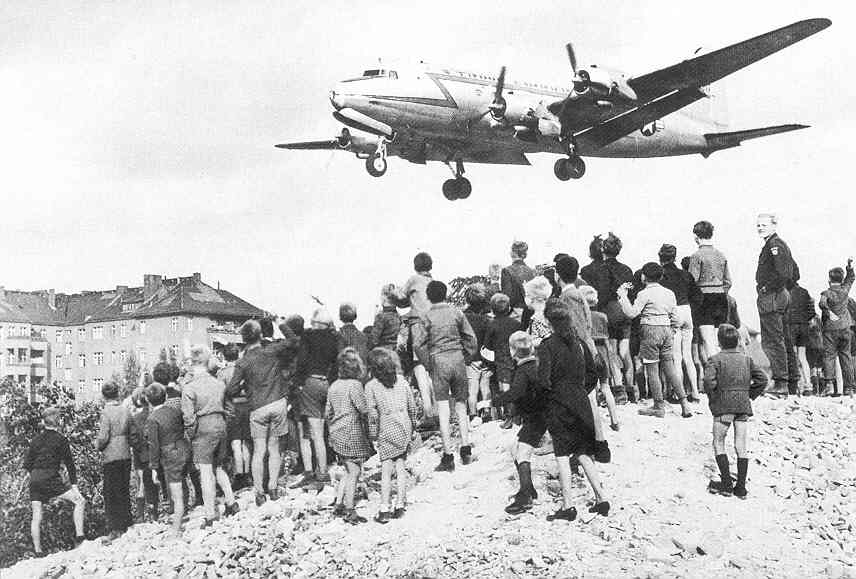
But Truman was not one to be easily backed down, and continued round-the-clock flights, bringing in food and other needed supplies through the rest of the year – even flying in coal to heat the Berlin homes that winter. And as part of the dynamic, the American airlift was so popular that the Communists were voted out of power in “West Berlin” in elections that December. Then, by the next year, the continuation of these flights was increasing dramatically the world’s respect for Truman and America, and making Stalin look bad. Thus Stalin in May of 1949 finally backed down and reopened the land routes to Berlin. The Berlin blockade was over, although a 3-month additional supply continued to be flown in just to secure matters for the West!
And all of this served greatly to bring the French, British and Americans closely together as Cold War allies, and cause the Germans (West Germans anyway) to see these nations not as occupiers but as protectors.
NATO. All of this proved additionally that the United Nations was not going to be the international peacemaker that Roosevelt, and even Truman at one point, hoped it would be. No, peace-securing diplomacy was going to have to find a different path in order that the world not find itself once again under international tyranny. And for the “West,” that would take the form in April 1949 of the North Atlantic Treaty Organization (NATO), America’s first peacetime military alliance,* and the actual military organization that went with it, 35 military divisions under NATO Supreme Commander General Eisenhower, formed the next year in response to the breakout of the Korean War in June of 1950.
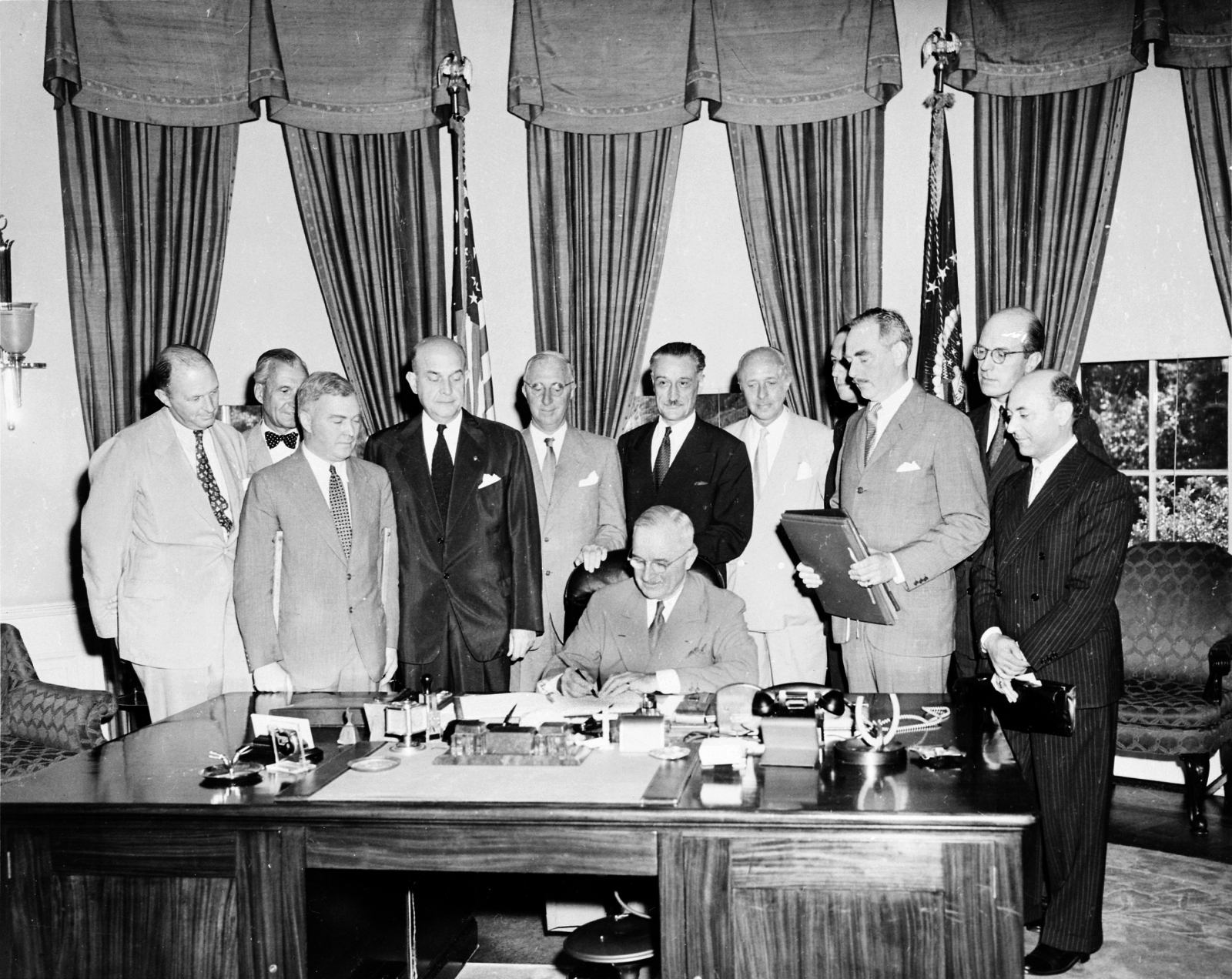
Truman signing the North Atlantic Treaty – 1949
 Helping Tito. One of the surprises along the way was how Truman moved to support his former opponent, Tito of Yugoslavia. It soon became apparent to Stalin that Tito had his own ideas of how he wanted to do “Communism” in Yugoslavia, and thus a deeply annoyed Stalin kicked Tito out of Stalin’s new international organization, Cominform.
Helping Tito. One of the surprises along the way was how Truman moved to support his former opponent, Tito of Yugoslavia. It soon became apparent to Stalin that Tito had his own ideas of how he wanted to do “Communism” in Yugoslavia, and thus a deeply annoyed Stalin kicked Tito out of Stalin’s new international organization, Cominform.
But Tito was no easy target. He killed, imprisoned or sentenced to forced labor some 50 thousand pro-Stalinist Communists in Yugoslavia.
And then Tito turned to Truman for help, requesting and receiving Marshall Plan aid, because Truman was more focused on blocking Stalinist expansion than on fighting Communist ideology. By helping Tito, this prevented Stalin from extending his reach across the Balkan peninsula down to the Adriatic Sea adjoining Italy and the Mediterranean, and ending his navy’s entrapment in the Black Sea. And with this shift in diplomacy, Tito then also ended any further threat to neighboring Greece.
This was another grand success for Truman and humiliation for Stalin, although anti-Communist American ideologists would have difficulty in seeing things in this manner. To them, “Communism” must always be opposed, no matter what form it takes.
A uniting of Western Europe. On the other hand, America’s European allies were just as alarmed about Germany and its revival. Thus it was that French foreign minister Robert Schuman came up with the idea in 1950 of creating a multinational authority with strong powers to oversee the strategic wartime industries of coal and steel production. The idea proved to be quite popular among the European citizenry, who were insistent that they should not be subjected to another violent outbreak of highly fired-up nationalism. And the idea had strong American support. Thus in April of 1951, representatives of West Germany (still under Western Occupation), France, Italy, Belgium, Netherlands, and Luxembourg met in Paris to sign the Paris Treaty establishing the European Coal and Steel Community (ECSC), placing those strategic industries under a multinational High Authority.
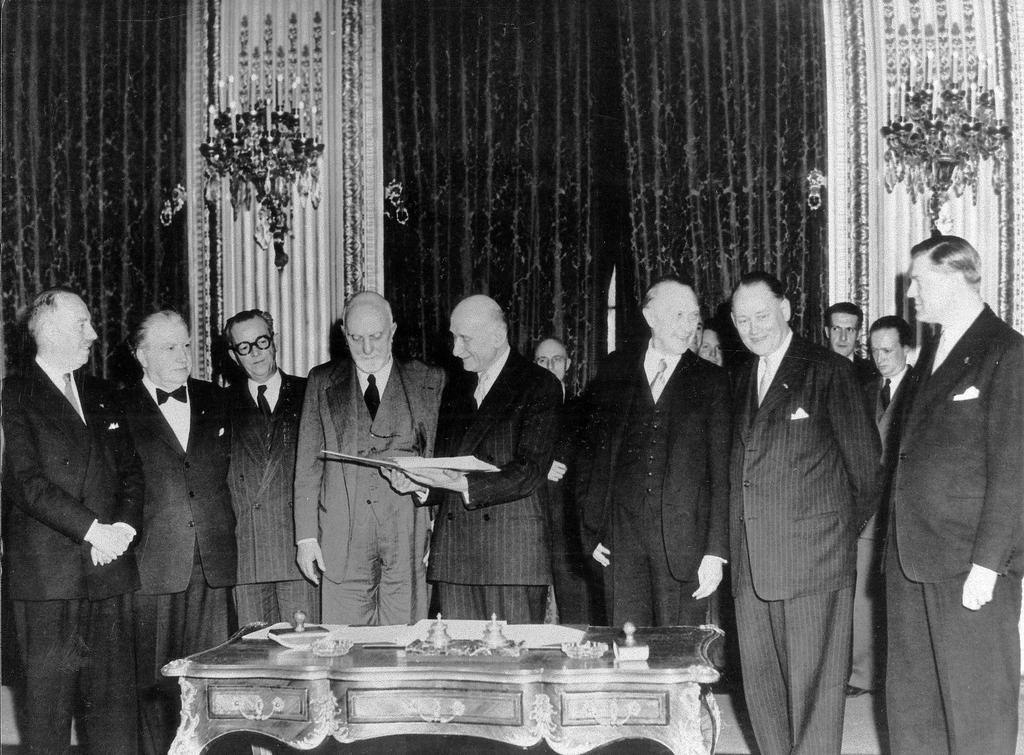
The signing of the Treaty of Paris – founding the ECSC and Euratom – 1951

Go on to the next section:
The Cold War Intensifies